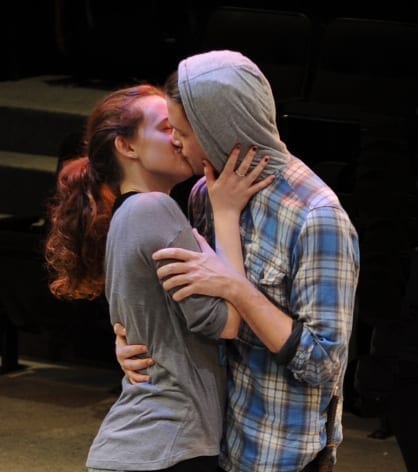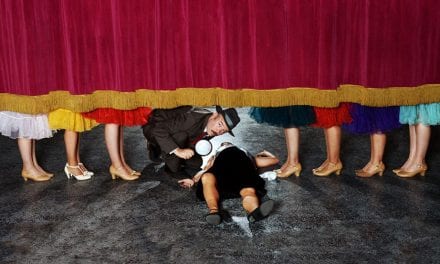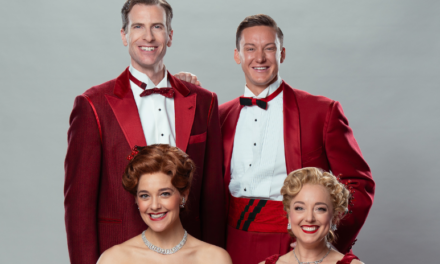SALT LAKE CITY — Romeo and Juliet, as penned by William Shakespeare, remains a constant of theater performance, attempted by many theatrical devotees and presented in a variety of lenses. The historic nature of true love, destroyed by the prideful hostility of parents, holds a certain resonance that speaks to audiences today. And while the words may be inaccessible to many, the universal truths Shakespeare manages to capture transcends time and continue to hold relevance in modern day. The University of Utah Department of Theatre presents their own flair on Romeo and Juliet, taking traditional Verona environment and bringing it to an urban street setting. Gone are the tokens of 14th century Italy, replaced with a grungy, inner-city gangland. Montagues and Capulets don more contemporary attire, fighting with saw-toothed knives and moshing to the spinning of an on-set DJ.
I thought the execution of the transposition of time went well. The story retained a resonance in the strain between Lords Montague and Capulet, apparently rival crime lords/gang leaders. Elements of design, namely costuming (Matti Ussery) and props, helped to keep the grungy street-world prevalent. Music drew upon the talents of Lana del Rey, and other current performers to transport the world into something, perhaps, more accessible to a modern audience. Costuming felt like items that could have come from the actor’s own closets, though relied on the traditional Capulet-Red and Montague-Blue dynamic.
The changes don’t end there, however. Director Sarah Shippobotham cast many traditionally male roles as woman, and vice-versa. Granted, we are aware that male actors played all parts in Shakesperean traditional practice, but the extent of gender-swapping was, at times, confusing and left me with many questions. Most notably, the roles of Lords Capulet and Montague, Lady Capulet, Nurse, and Benvolio were played opposite of written sex. Use of gender pronouns did not seem to matter, and as a theatrical tool, I became accustomed and fine with this. The consistency of this choice left me highly confused, however. Benvolio seemed to be played as female, but the rest of aforementioned roles were played in traditional gender. I did not know if Nurse, for example, was meant to be a woman or an excessively flamboyant male or if Lady Capulet was a flat house husband, or if the actor meant to play the role as female? I left still wondering what this meant, and indeed, if it was something that should have provoked as many unanswered questions as it did.
Characterization for some roles diverted from usual presentation. Mercutio (Steven Jones) lacked the usual charm and charisma of his person, and instead, felt like a tough New Yorker. The playful flirtations and overt wittiness disappeared into a wholly aggressive persona that alienated his friendship from Romeo. Indeed, instead of tried-and-true best friends their relationship felt like a hesitant kinship. It was a different dynamic that, while worked in some scenes, made the death of Mercutio far less poignant. I laud Jones, however, for sticking with this unusual interpretation, and presenting characterization so well. He stood out, and even if I didn’t like the character, his presence on stage was appreciated. One presence I found myself growing to dislike, unfortunately, was that of Juliet (September McKinnon). McKinnon lacked the beautiful naivety of an ingenue, and I failed to see why Romeo would fall in love with her at first sight. In fact, I came to resent McKinnon’s time on stage. Moreover, the actress fell easily into a cadence with verse, and lines lacked any real variety or sense of being grounded with deliverance. Indeed, the most beauty in her performance came with two fraught breaths right before she killed herself because it was then that I saw a legitimate fear and sadness in her face. But when faced with the dense verse of Shakespeare, McKinnon fell flat.
A lot of individual performances fell in this same monotone caricature of personality, and I was generally disappointed or bored by the action on stage. A few characters held my attention, however, and seemed to carry the whole energy of the show. Romeo (Mike T. Brown), Lord Capulet (Taylor Kirch), Paris (Michael S. Johnson), Nurse (Taylor Smith), Prince (Kirsten Jade Allen), and—towards the end of her scenes Benvolio (Kate Mikell)— were all portrayed by actors who were grounded in their performance and genuinely understood the weight of the words they spoke. They were having fun on stage and attracted my attention more so than others, via delivery of lines and purposeful gesticulations. Johnson demonstrated such a lovely subtle energy that I wished he had more time onstage, so very lovely was Johnson’ performance. Kirch too brought a formidable and street-wise maturity that fit her role. I appreciated Kirch’s ability to convey story amidst the mercurial emotions of Lord Capulet. And Romeo! Brown was an absolute star of this show, and I lived for the moments he was onstage. The charismatic ease of a love-struck Romeo was just as enthralling as a hopeless, despairing Romeo; every time Brown entered the stage, a renewed sense of energy invigorated the space. He felt so very natural and at ease with everything, and I believed every word he spoke. The confrontation with Tybalt, his scene in Juliet’s tomb, his conversations with Friar Lawrence, each time Brown brought a tangible shift in the pacing and energy.
A surprise stand out of this show was the fight choreography (Caroline Haydon). Every fight had an absolute sense of urgency and tension to them. The danger seemed real, and I loved the innovations that came into play because of the urban setting. It should be noted that the choreography in itself was quite aggressive, and lends to this play’s apparent R-rated content. I appreciated the violence in this context because it was legitimized in the world of play. Other such things—overt phallic humor and rampantly horny teenagers—seemed gratuitous in performance. I understand that Shakespeare wrote a lot of bawdy humor into this play, but the passing around of a baseball bat and mimicking jacking off only detracted from the words. The humor seemed to be masking low levels of energy and dialogue delivery. Had it served the general context, I wouldn’t have minded. The sexual humour absolutely provided a few well-needed laughs, but when pushed to exhaustion, only felt boring.
Blocking, in general, was a strength of this production. A thrust stage often provides some difficulty in presentation, but there was always something interesting to watch. There were a few moments when entrances seemed to contradict the precedent set by previous movement. For example, the entrances to the tomb. Paris, Romeo, and Friar Lawrence all entered in different ways. For the most part, however, Shippobotham’s blocking was conducive to the space and uplifted the performance. Use of space proved a strength in this performance. Actors were conscientious about addressing each section of audience and were very deliberate in choosing which group to speak to. Furthermore, diction and volume were always clear, and I could quite easily understand the words spoken by everyone. Moreover, Shippobotham’s careful handling of the script afforded for legitimate comedy to unfold until Mercutio’s untimely death, and the script’s spiraling into tragedy from there. What didn’t quite work for me were the snippets of irreverent humor once genre turned tragic because it removed me from that sense of being lost in the show.
Overall, Romeo and Juliet was a generally lackluster production that left me with many questions, and an unsatisfied hunger for theater. It seemed as though Shippobotham had many provocative ideas and tried to incorporate a vast number of them into the space of a play. But the execution faltered. The transition of setting into urbanite crime absolutely worked, though I found myself overloaded by the sheer number of “conceptual” items. Integration of every different aspects—the modern setting, one modern dance, gender swapping, and actor placement in the audience—never fell into synergy with each other. However, I appreciated the rare moments of brilliance, provided largely in part by Brown. Locals might be interested in the experience. However, I would not make the drive or spend the $10.50-18 to see this.









